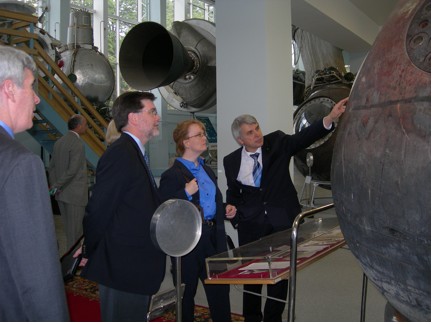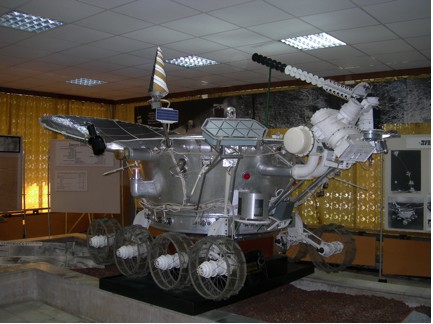Why a Blog?
I am looking for a more direct way to communicate with people inside the agency. There is so much that goes on at headquarters and I want to be able to pull the curtain back on at least some of it and also explain what is going on with new initiatives. I anticipate updating the blog every week — I know, not as routine as many but it’s hard even to find time to eat lunch.
International Meetings
I just returned from a trip to Europe and Russia to meet with my international counterparts and I believe we had very productive discussions regarding current and potential future cooperation. A primary goal for my visits was to discuss potential areas of collaboration in exploration. Great progress has been made. When I first came to the agency in November 2005, our ISS partners were very concerned about NASA’s commitment to assemble the space station. I believe they have all come to realize, mainly through our actions, that we are fully committed to assembly and use of the ISS. As a result, our ISS partners are now in a position to begin serious discussions with NASA on opportunities for human and robotic exploration of the Moon, Mars and beyond.
The German Aerospace Center (DLR) and the Italian Space Agency (ASI) both have new leaders so I felt it was important to establish relations with them at the senior leadership level and personally explain NASA’s strong interest in continuing our long history of successful cooperation with their agencies. Also, despite several personal invitations from the Head of the Russian Federal Space Agency, Roscosmos, I had not yet had an opportunity to visit Russia in my capacity at NASA and given their extensive experience in human space flight and exploration activities I wanted to see some of their facilities.
While I was in Europe, although my schedule did not permit me to attend, there was an international exploration workshop in Spineto, Italy, where representatives from 14 space agencies, including NASA, concluded a framework for the Global Exploration Strategy for lunar exploration.
In Cologne, Germany, I met with Professor Johann-Dietrich Wörner, who became Chairman of the Executive Board of DLR in March. Professor Wörner told me that DLR is conducting a feasibility study to assess whether DLR will pursue a lunar orbiter mission to survey the lunar surface. The results of the feasibility study will be finalized by the end of the year. The German science community seems interested in lunar science, and I felt that my meetings there were quite positive and that there will be significant opportunities for enhanced NASA-DLR cooperation in the future.
I then traveled from Germany to Rome where I met with Professor Giovanni Fabrizio Bignami, President of ASI. Professor Bignami began his tenure as ASI President at the end of April and this was the first NASA meeting with him. ASI is currently undergoing a process to assess Italy’s science objectives and requirements. Given our long history of successful cooperation with Italy, including major cooperative initiatives in human space flight and Earth and space science, I look forward to further discussions with ASI to explore ASI interests in lunar exploration and other potential areas of cooperation.
In Moscow, I met with Mr. Anatoli Nikolaevich Perminov, Head of Roscosmos. Russia’s 10-year plan for space goes through 2015, but Russia is in the process of developing a longer-range strategic plan for 2016-2040. Roscosmos indicated a willingness to discuss lunar cooperation further. Also in Moscow, I visited Khrunichev State Space Science Production Center where I saw a full-scale mock-up of the Mir Space Station, Proton launch vehicles, Angara launch vehicles and several other impressive pieces of flight hardware, and met with Khrunichev’s Deputy Director, Dr. Kuzin. I also went to Mission Control Center — Moscow, met the Director, and had a great discussion with both Russian and NASA staff stationed there. At Rocket Space Corporation — Energia, I met with Energia President Nikolai Sevastianov and he led me on a tour of their factory floor and museum. At the museum, we saw actual flight hardware from Russia’s early human space flight missions, including Yuri Gagarin’s capsule — it was amazing!


On the left above is me at the Rocket Space Corporation — Energia. I met with Energia President Nikolai Sevastianov and he led me on a tour of their factory floor and museum.
I then met with Dr. Polishchuk, General Director and General Designer of NPO Lavochkin. Lavochkin’s Luna 16 mission returned 101 grams of lunar soil on September 24, 1970. With an impressive array of space exploration missions including a wide range of planetary missions, I am confident that Lavochkin will continue to play a key role in future space exploration activities.
Personal Notes
As a Food Network fan, I tried to take every advantage of my foreign travel to taste the local cuisine. I had some wonderful cheese in Germany, incredible prosciutto and pastas in Italy and amazing cheesy bread in Russia called Khachapuri. Although Moscow is a beautiful city, the volume of traffic in and around the city can only be believed once you experience it. In one case, we departed a facility at 1:30 p.m. and had allotted 1½ hours to reach our next stop which was only about 10-15 miles away. In the end it took over two hours in stop-and-go traffic. Having said that, at each stop our Russian hosts apologized for the traffic in their city and graciously modified their schedules to maximize the time available. I flew from Russia to Orlando for the launch of STS-117. It takes my breath away every time I see a Shuttle launch — the sheer majesty and the way it rumbles through your body cannot be adequately articulated. I wish every American could experience it.
Next Trip
On Sunday June 17, I fly to Colorado for meetings there and then in Arizona with leaders of industry and academia as well as local officials to discuss support for America’s space program. I will tell you more about these meetings in future postings.
For more information on HSPD-12, please visit http://hspd12.nasa.gov.
